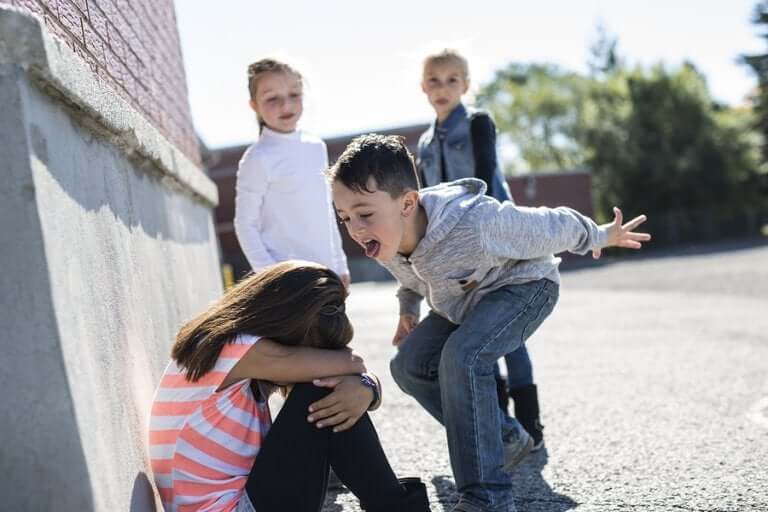How Can I Report Bullying?

Bullying has become a real social problem. Every day, new cases that deeply affect many children and their families come to light. Fortunately, as the number of cases has grown, so have the number of complaints, and so have the measures to protect children and adolescents. Keep reading to learn how to detect and report bullying as quickly as possible.
To prevent and correct these types of situations, it’s essential to report them. Sometimes it isn’t easy to accept that one of our children is being bullied. However, it’s very important to face the situation and, if we’re sure that it’s happening, to report it without delay.
What is bullying?
Before we can make a report, we must be sure that we’re dealing with a case of bullying. Making fun of a classmate isn’t the same as repeated humiliation, threats, or exclusion.
The main characteristic of this type of bullying is its permanence. It isn’t an occasional and isolated event, but rather a repeated and habitual situation that intensifies over time.

Bullying has been defined as a form of physical, psychological, or social coercion or humiliation that occurs in the school environment. This situation affects the physical and emotional well-being of the victim.
Currently, the issue of bullying is aggravated by cases of cyber-bullying. In these cases, the situation of harassment extends beyond the school environment and, moreover, it’s anonymous.
So, what should we do when we suspect that this type of situation may be happening to our children? First of all, it’s essential to investigate further in order to confirm whether we’re dealing with a case of school bullying or not. And, if so, you’ll need to act as quickly as possible.
How to detect it?
There are some signs that can help parents to quickly detect that their child could be facing a potential bullying situation. The first thing, of course, is to listen carefully to what your child tells you. Be aware of possible marks on their body, such as bruises, scratches, etc.
Besides listening to what our children have to say, the most common signs are bad moods, sadness, sleep problems, fear of going to school, lack of appetite, etc.
Who can you turn to to report bullying?
If we’re sure that our child is being bullied, the first thing we should do is go to the school immediately. We should ask to speak to the person responsible for cases like this.
It’s also important to make a written statement explaining what’s happening and requesting the intervention of school authorities to solve the situation. Many schools have contingency plans for cases like these.
If the school authorities don’t do anything, or don’t act firmly enough, and the situation doesn’t improve, then the next step is to go to a higher education body. These bodies also have specific protocols for intervening in these cases and providing solutions.
If the case is serious, and a crime has been committed, then the Inspector will inform the Office for the Public Protection of Minors. This body will then be responsible for continuing to monitor the case.
If the problem can’t be resolved through administrative channels, then the courts must be called upon to deal with it. In fact, there are currently lawyers who specialize in cases of bullying or harassment.
In the case of physical aggression or threats, you can start criminal proceedings. Depending on the type of behavior of the aggressor, it’s possible that the child could be interned in a center for minors.

What evidence is needed to report bullying?
Evidence is a critical part of the process of reporting bullying. It’s important to keep a copy of all written communications and minutes of meetings with school authorities. It’s also helpful to have a psychological report that describes how much the child is affected and what treatment, if any, the child is receiving.
Copies of emails, screenshots of social network postings, WhatsApp messages, etc., are also very useful during this process. You can also use testimony from peers and teachers that may confirm that bullying is taking place.
Bullying has become a real social problem. Every day, new cases that deeply affect many children and their families come to light. Fortunately, as the number of cases has grown, so have the number of complaints, and so have the measures to protect children and adolescents. Keep reading to learn how to detect and report bullying as quickly as possible.
To prevent and correct these types of situations, it’s essential to report them. Sometimes it isn’t easy to accept that one of our children is being bullied. However, it’s very important to face the situation and, if we’re sure that it’s happening, to report it without delay.
What is bullying?
Before we can make a report, we must be sure that we’re dealing with a case of bullying. Making fun of a classmate isn’t the same as repeated humiliation, threats, or exclusion.
The main characteristic of this type of bullying is its permanence. It isn’t an occasional and isolated event, but rather a repeated and habitual situation that intensifies over time.

Bullying has been defined as a form of physical, psychological, or social coercion or humiliation that occurs in the school environment. This situation affects the physical and emotional well-being of the victim.
Currently, the issue of bullying is aggravated by cases of cyber-bullying. In these cases, the situation of harassment extends beyond the school environment and, moreover, it’s anonymous.
So, what should we do when we suspect that this type of situation may be happening to our children? First of all, it’s essential to investigate further in order to confirm whether we’re dealing with a case of school bullying or not. And, if so, you’ll need to act as quickly as possible.
How to detect it?
There are some signs that can help parents to quickly detect that their child could be facing a potential bullying situation. The first thing, of course, is to listen carefully to what your child tells you. Be aware of possible marks on their body, such as bruises, scratches, etc.
Besides listening to what our children have to say, the most common signs are bad moods, sadness, sleep problems, fear of going to school, lack of appetite, etc.
Who can you turn to to report bullying?
If we’re sure that our child is being bullied, the first thing we should do is go to the school immediately. We should ask to speak to the person responsible for cases like this.
It’s also important to make a written statement explaining what’s happening and requesting the intervention of school authorities to solve the situation. Many schools have contingency plans for cases like these.
If the school authorities don’t do anything, or don’t act firmly enough, and the situation doesn’t improve, then the next step is to go to a higher education body. These bodies also have specific protocols for intervening in these cases and providing solutions.
If the case is serious, and a crime has been committed, then the Inspector will inform the Office for the Public Protection of Minors. This body will then be responsible for continuing to monitor the case.
If the problem can’t be resolved through administrative channels, then the courts must be called upon to deal with it. In fact, there are currently lawyers who specialize in cases of bullying or harassment.
In the case of physical aggression or threats, you can start criminal proceedings. Depending on the type of behavior of the aggressor, it’s possible that the child could be interned in a center for minors.

What evidence is needed to report bullying?
Evidence is a critical part of the process of reporting bullying. It’s important to keep a copy of all written communications and minutes of meetings with school authorities. It’s also helpful to have a psychological report that describes how much the child is affected and what treatment, if any, the child is receiving.
Copies of emails, screenshots of social network postings, WhatsApp messages, etc., are also very useful during this process. You can also use testimony from peers and teachers that may confirm that bullying is taking place.
All cited sources were thoroughly reviewed by our team to ensure their quality, reliability, currency, and validity. The bibliography of this article was considered reliable and of academic or scientific accuracy.
- acabemosconelbullying.com. Cómo detectar y actuar contra el acoso escolar. Extraído de: https://www.acabemosconelbullying.com/recursos/pdf/MANUAL_PADRES_Y_PROFESORES_ACOSO.pdf
- injuve.es. (2017). Las familias ante el acoso escolar. Extraído de: http://www.injuve.es/sites/default/files/2017/42/publicaciones/documentos_7._las_familias_ante_el_acoso_escolar.pdf
This text is provided for informational purposes only and does not replace consultation with a professional. If in doubt, consult your specialist.








